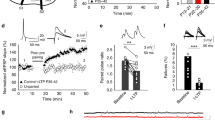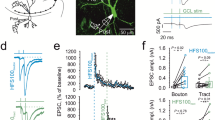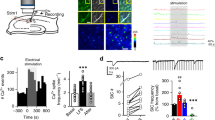Abstract
The induction of associative synaptic plasticity in the mammalian central nervous system classically depends on coincident presynaptic and postsynaptic activity1,2. According to this principle, associative homosynaptic long-term potentiation (LTP) of excitatory synaptic transmission can be induced only if synaptic release occurs during postsynaptic depolarization1,2. In contrast, heterosynaptic plasticity in mammals is considered to rely on activity-independent, non-associative processes3,4,5,6,7,8. Here we describe a novel mechanism underlying the induction of associative LTP in the lateral amygdala (LA). Simultaneous activation of converging cortical and thalamic afferents specifically induced associative, N-methyl-d-aspartate (NMDA)-receptor-dependent LTP at cortical, but not at thalamic, inputs. Surprisingly, the induction of associative LTP at cortical inputs was completely independent of postsynaptic activity, including depolarization, postsynaptic NMDA receptor activation or an increase in postsynaptic Ca2+ concentration, and did not require network activity. LTP expression was mediated by a persistent increase in the presynaptic probability of release at cortical afferents. Our study shows the presynaptic induction and expression of heterosynaptic and associative synaptic plasticity on simultaneous activity of converging afferents. Our data indicate that input specificity of associative LTP can be determined exclusively by presynaptic properties.
This is a preview of subscription content, access via your institution
Access options
Subscribe to this journal
Receive 51 print issues and online access
$199.00 per year
only $3.90 per issue
Buy this article
- Purchase on Springer Link
- Instant access to full article PDF
Prices may be subject to local taxes which are calculated during checkout




Similar content being viewed by others
References
Gustafsson, B. & Wigström, H. Basic features of long-term potentiation in the hippocampus. Semin. Neurosci. 2, 321–333 (1990)
Bliss, T. V. P. & Collingridge, G. L. A synaptic model of memory: long-term potentiation in the hippocampus. Nature 361, 31–39 (1993)
Bailey, C. H., Giustetto, M., Huang, Y. Y., Hawkins, R. D. & Kandel, E. R. Is heterosynaptic modulation essential for stabilizing Hebbian plasticity and memory? Nature Rev. Neurosci. 1, 11–20 (2000)
Artola, A. & Singer, W. Long-term depression of excitatory synaptic transmission and its relationship to long-term potentiation. Trends Neurosci. 16, 480–487 (1993)
Scanziani, M., Malenka, R. C. & Nicoll, R. A. Role of intercellular interactions in heterosynaptic long-term depression. Nature 380, 446–450 (1996)
Tsukamoto, M. et al. Mossy fibre synaptic NMDA receptors trigger non-Hebbian long-term potentiation at entorhino-CA3 synapses in the rat. J. Physiol. (Lond.) 546, 665–675 (2003)
Royer, S. & Paré, D. Conservation of total synaptic weight through balanced synaptic depression and potentiation. Nature 422, 518–522 (2003)
Nishiyama, M., Hong, K., Mikoshiba, K., Poo, M. M. & Kato, K. Calcium stores regulate the polarity and input-specificity of synaptic modification. Nature 408, 584–588 (2000)
LeDoux, J. E. Emotion circuits in the brain. Annu. Rev. Neurosci. 23, 155–184 (2000)
Weisskopf, M. G., Bauer, E. P. & LeDoux, J. E. L-type voltage gated calcium channels mediate NMDA-independent associative long-term potentiation at thalamic input synapses to the amygdala. J. Neurosci. 19, 10512–10519 (1999)
Bauer, E. P., Schafe, G. E. & LeDoux, J. E. NMDA receptors and L-type voltage gated calcium channels contribute to long-term potentiation and different components of fear memory formation in the lateral amygdala. J. Neurosci. 22, 5239–5249 (2002)
Huang, Y. Y. & Kandel, E. R. Postsynaptic induction and PKA-dependent expression of LTP in the lateral amygdala. Neuron 21, 169–178 (1998)
Quirk, G. J., Armony, J. L. & LeDoux, J. E. Fear conditioning enhances different temporal components of tone-evoked spike trains in auditory cortex and lateral amygdala. Neuron 19, 613–624 (1997)
Rosenkranz, J. A. & Grace, A. A. Dopamine-mediated modulation of odour-evoked amygdala potentials during pavlovian conditioning. Nature 417, 282–287 (2002)
Berretta, N. & Jones, R. S. Tonic facilitation of glutamate release by presynaptic N-methyl-d-aspartate autoreceptors in the entorhinal cortex. Neuroscience 75, 339–344 (1996)
Lang, E. J. & Paré, D. Similar inhibitory processes dominate the responses of cat lateral amygdaloid projection neurons to their various afferents. J. Neurophysiol. 77, 341–352 (1997)
Szinyei, C., Heinbockel, T., Montagne, J. & Pape, H. C. Putative cortical and thalamic inputs elicit convergent excitation in a population of GABAergic interneurons of the lateral amygdala. J. Neurosci. 20, 8909–8915 (2000)
Abraham, W. C. & Wickens, J. R. Heterosynaptic long-term depression is facilitated by blockade of inhibition in area CA1 of the hippocampus. Brain Res. 546, 336–340 (1991)
Lang, E. J. & Paré, D. Synaptic responsiveness of interneurons of the cat lateral amygdaloid nucleus. Neuroscience 83, 877–889 (1998)
Bissière, S., Humeau, Y. & Lüthi, A. Dopamine gates LTP induction in lateral amygdala by suppressing feedforward inhibition. Nature Neurosci. 6, 587–592 (2003)
McDonald, A. J. & Mascagni, F. Immunohistochemical localization of the β2 and β3 subunits of the GABAA receptor in the basolateral amygdala of the rat and monkey. Neuroscience 75, 407–419 (1996)
Farb, C. R., Aoki, C. & LeDoux, J. E. Differential localization of NMDA and AMPA receptor subunits in the lateral and basal nuclei of the amygdala: a light and electron microscopic study. J. Comp. Neurol. 362, 86–108 (1995)
Gracy, K. N. & Pickel, V. M. Ultrastructural localization of NMDAR1 glutamate receptor immunoreactivity in the extended amygdala. J. Comp. Neurol. 362, 71–85 (1995)
Farb, C. R. & LeDoux, J. E. Afferents from the rat temporal cortex synapse on lateral amygdala neurons that express AMPA and NMDA receptors. Synapse 33, 218–229 (1999)
Hess, G., Kuhnt, U. & Voronin, L. L. Quantal analysis of paired-pulse facilitation in guinea pig hippocampal slices. Neurosci. Lett. 77, 187–192 (1987)
Tsvetkov, E., Carlezon, W. A., Benes, F. M., Kandel, E. R. & Bolshakov, V. Y. Fear conditioning occludes LTP-induced presynaptic enhancement of synaptic transmission in the cortical pathway to the lateral amygdala. Neuron 34, 289–300 (2002)
Humeau, Y., Popoff, M. R., Kojima, H., Doussau, F. & Poulain, B. Rac GTPase plays an essential role in exocytosis by controlling the fusion competence of release sites. J. Neurosci. 22, 7968–7981 (2002)
Doyère, V., Schafe, G. E., Sigurdsson, T. & LeDoux, J. E. Long-term potentiation in freely moving rats reveals asymmetries in thalamic and cortical inputs to the lateral amygdala. Eur. J. Neurosci. 17, 2703–2715 (2003)
Markram, H., Lübke, J., Frotscher, M. & Sakman, B. Regulation of synaptic efficacy by coincidence of postsynaptic APs and EPSPs. Science 75, 213–215 (1997)
Blair, H. T., Schafe, G. E., Bauer, E. P., Rodrigues, S. M. & LeDoux, J. E. Synaptic plasticity in the lateral amygdala: a cellular hypothesis of fear conditioning. Learn. Mem. 8, 229–242 (2001)
Acknowledgements
We thank B. Gähwiler, C. Heuss, A. Matus, B. Poulain and E. Seifritz for discussions and comments on the manuscript. This work was supported by the Borderline Personality Disorder Research Foundation, the Swiss National Science Foundation and the Novartis Research Foundation.
Author information
Authors and Affiliations
Corresponding author
Ethics declarations
Competing interests
The authors declare that they have no competing financial interests.
Rights and permissions
About this article
Cite this article
Humeau, Y., Shaban, H., Bissière, S. et al. Presynaptic induction of heterosynaptic associative plasticity in the mammalian brain. Nature 426, 841–845 (2003). https://doi.org/10.1038/nature02194
Received:
Accepted:
Issue Date:
DOI: https://doi.org/10.1038/nature02194
This article is cited by
-
Presynaptic NMDARs on spinal nociceptor terminals state-dependently modulate synaptic transmission and pain
Nature Communications (2022)
-
Inhibition of NMDA receptors through a membrane-to-channel path
Nature Communications (2022)
-
Single cell plasticity and population coding stability in auditory thalamus upon associative learning
Nature Communications (2021)
-
Prefrontal-amygdala plasticity enabled by observational fear
Neuropsychopharmacology (2019)
-
Presynaptic NMDA receptors control nociceptive transmission at the spinal cord level in neuropathic pain
Cellular and Molecular Life Sciences (2019)
Comments
By submitting a comment you agree to abide by our Terms and Community Guidelines. If you find something abusive or that does not comply with our terms or guidelines please flag it as inappropriate.



